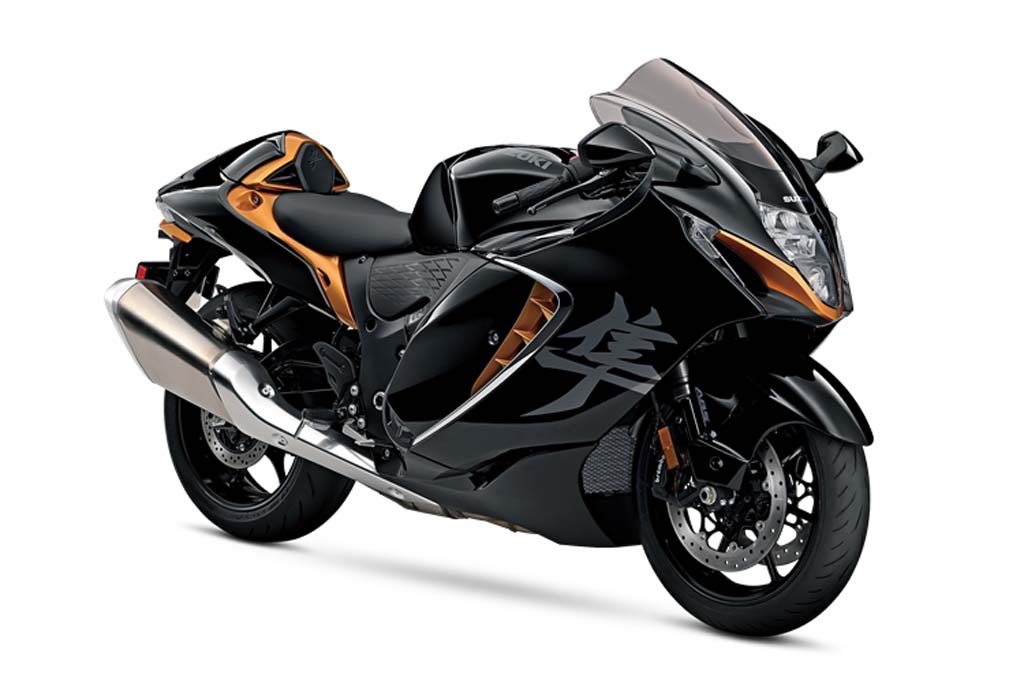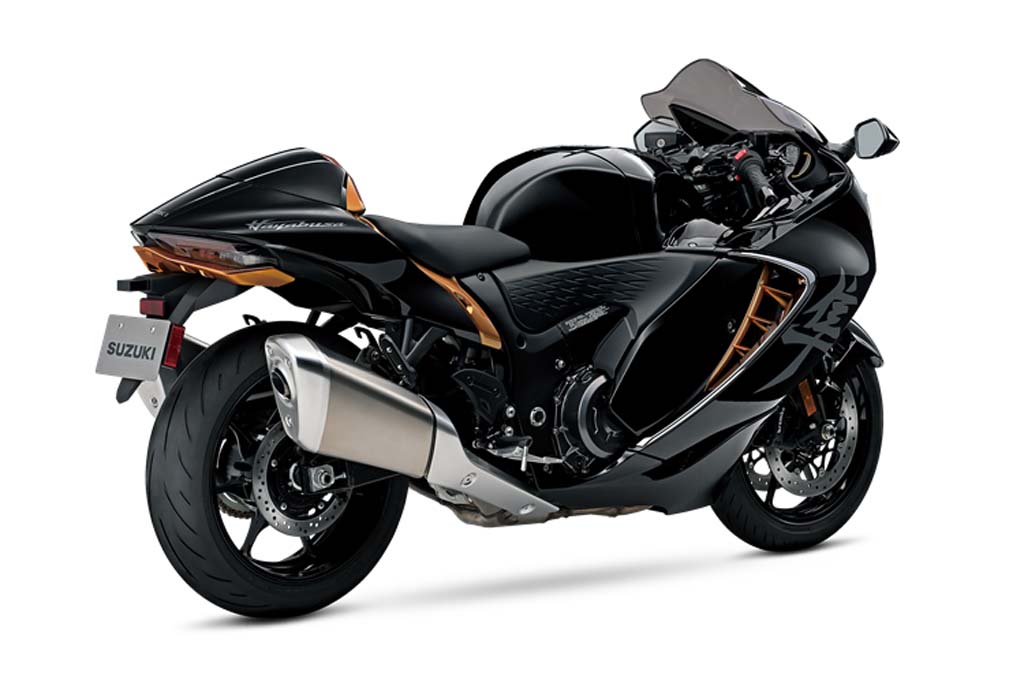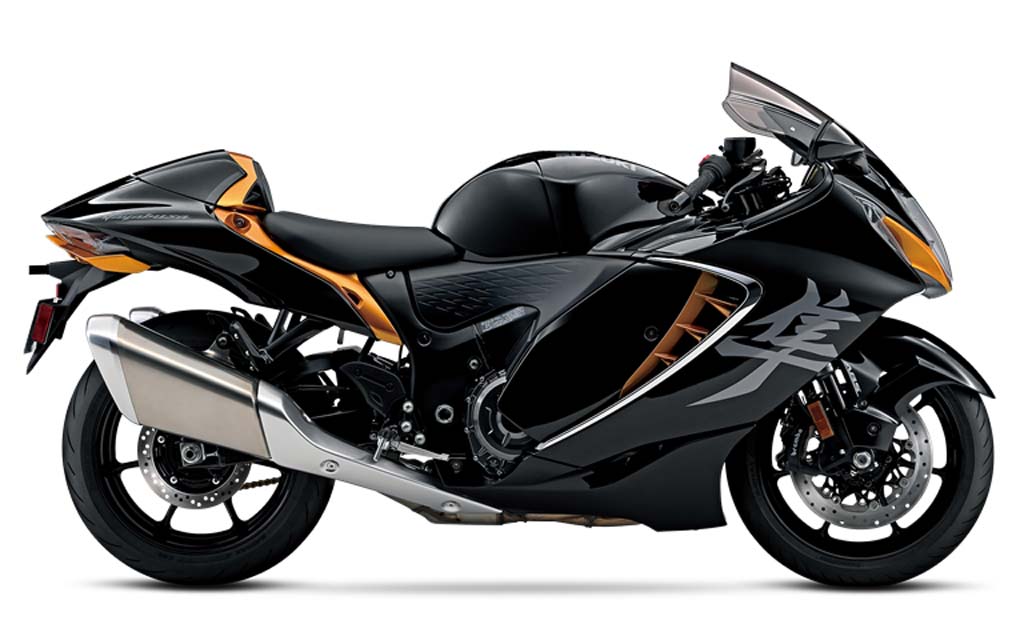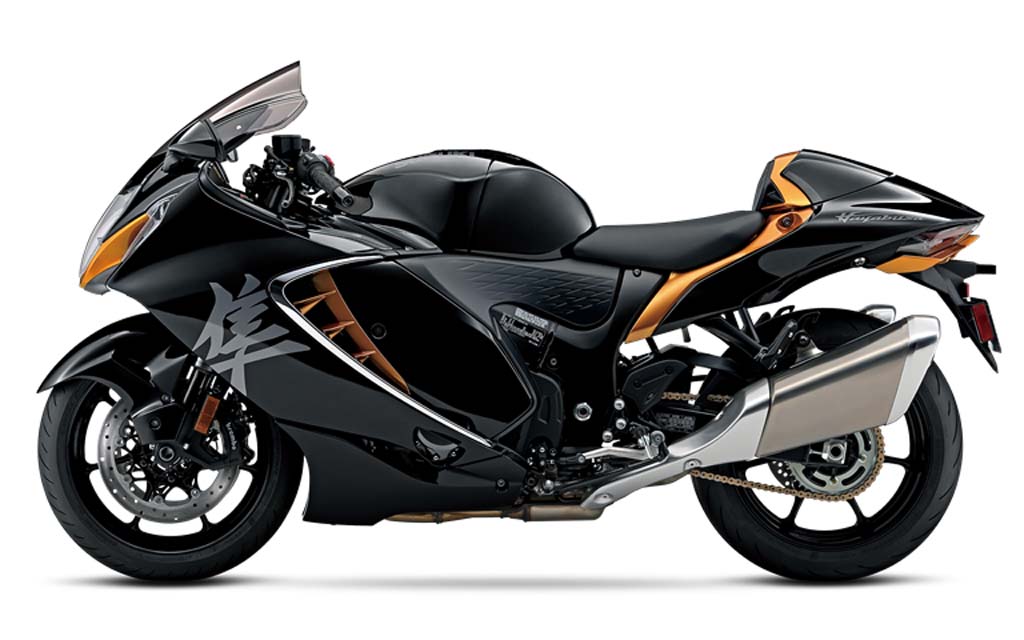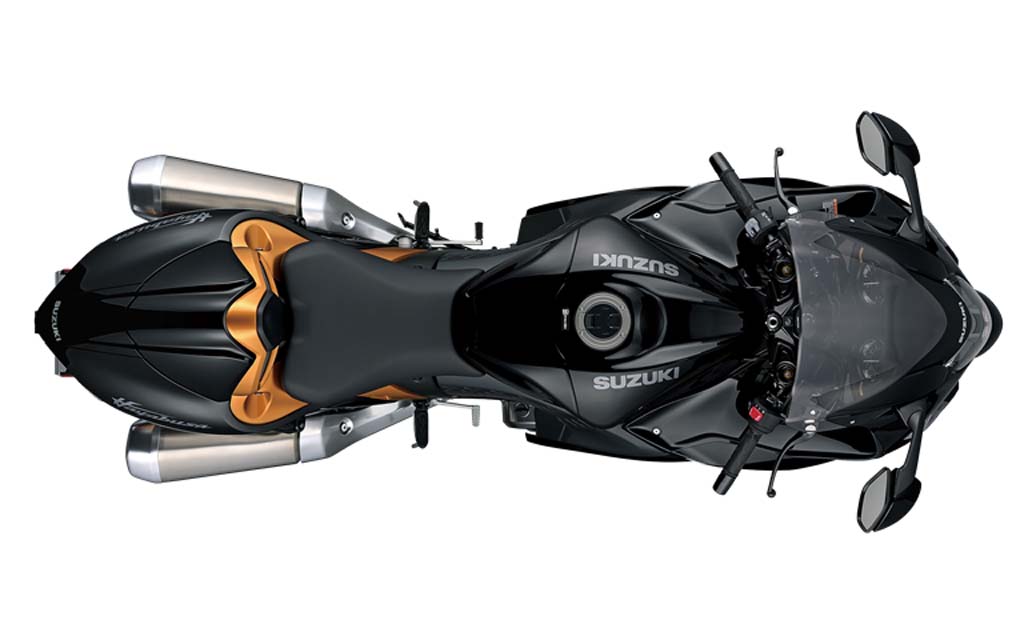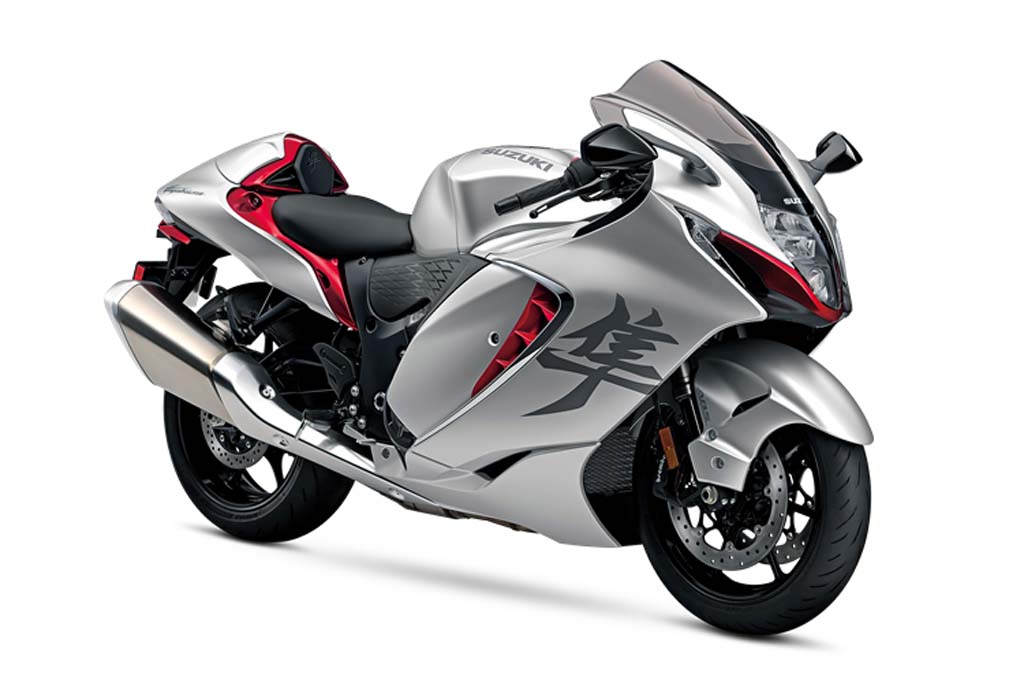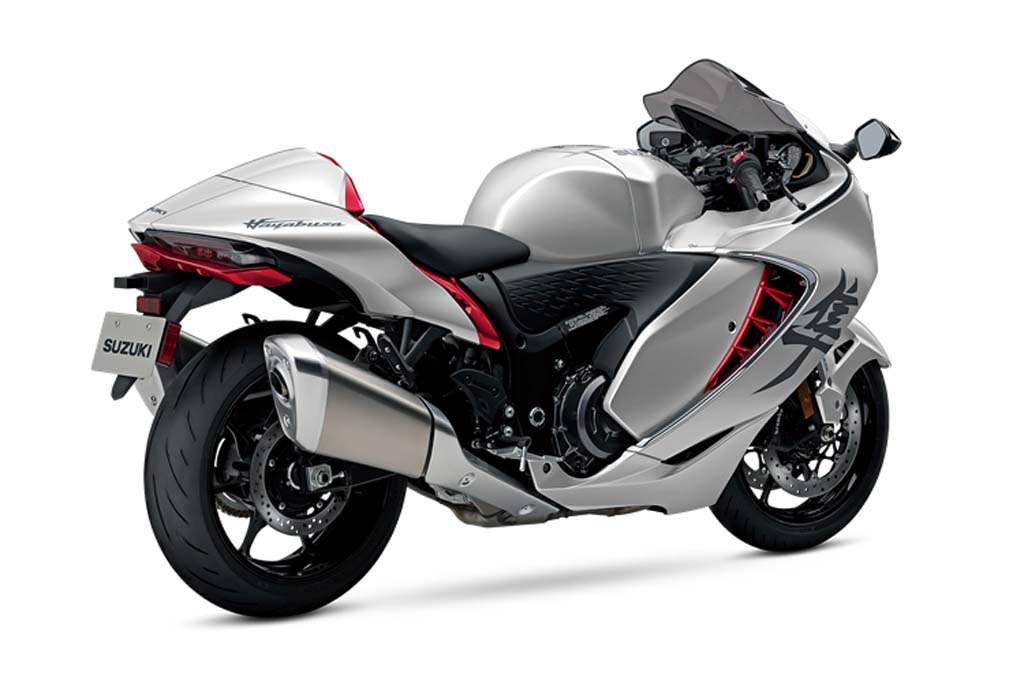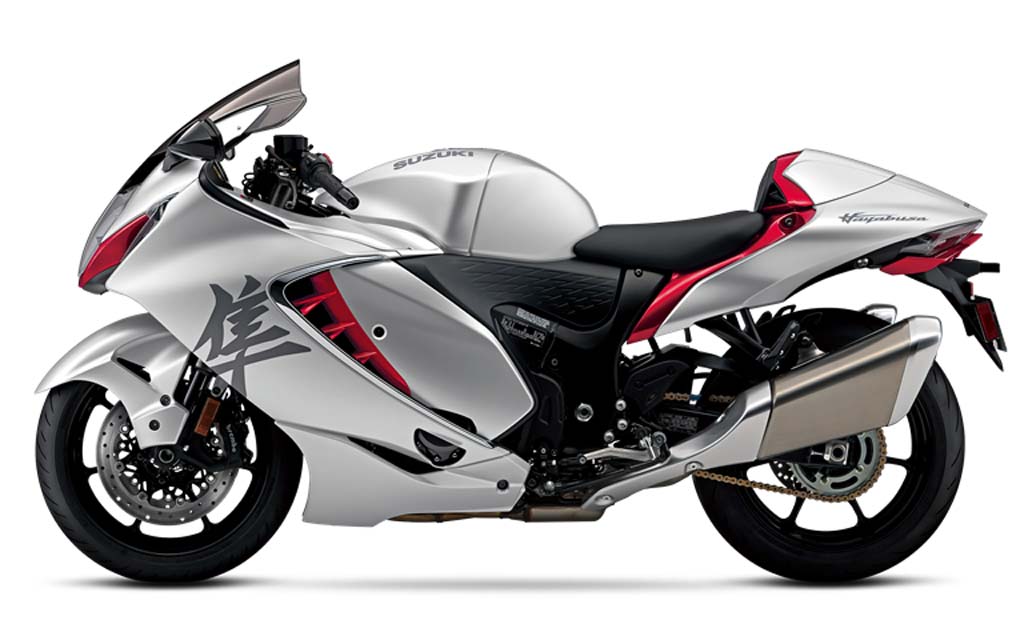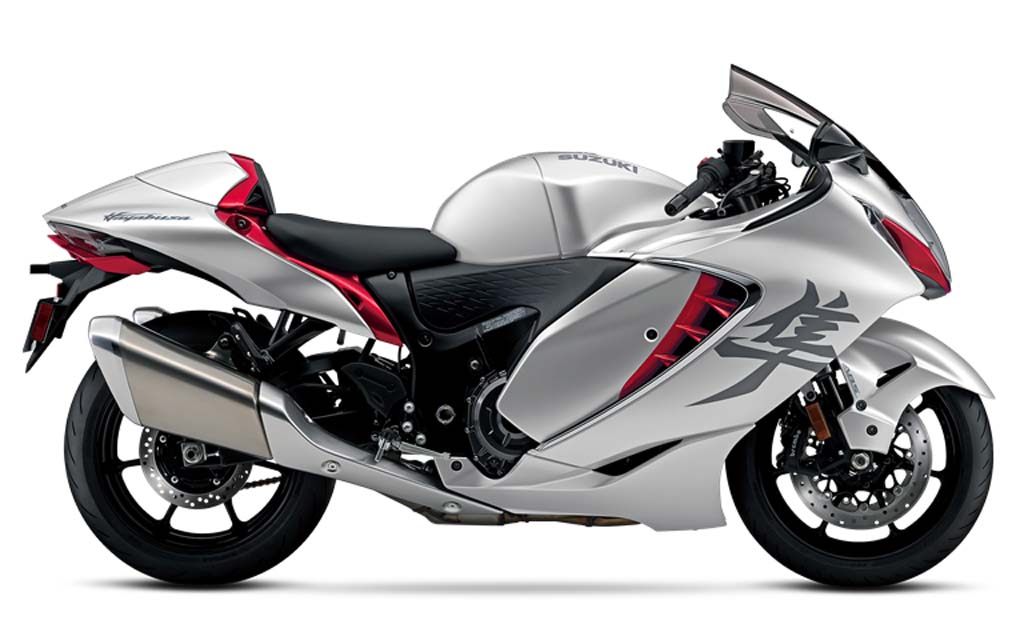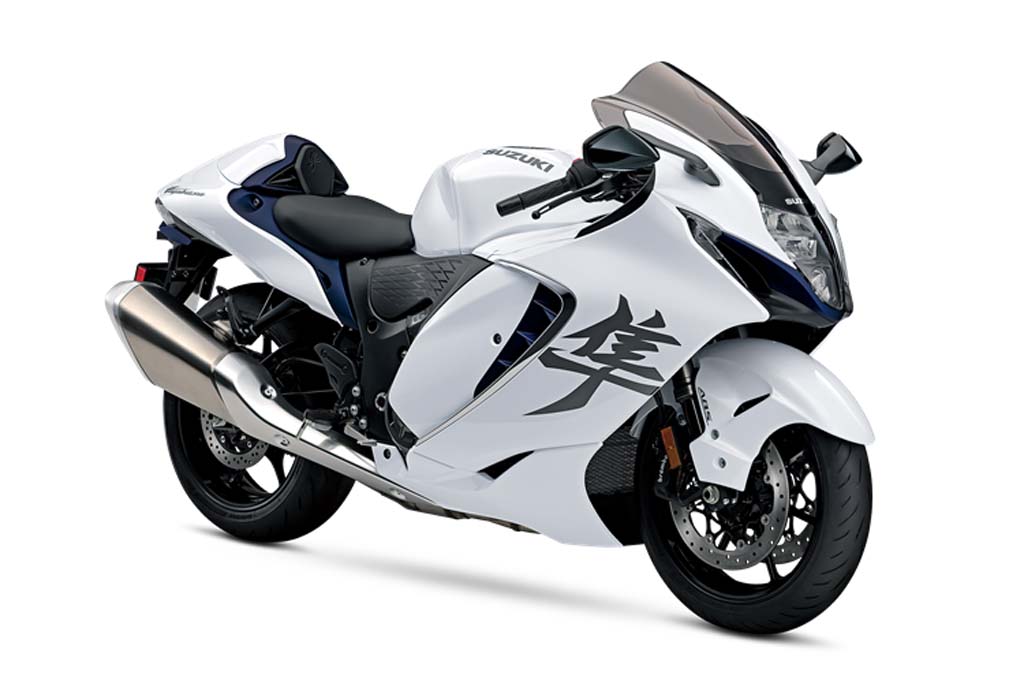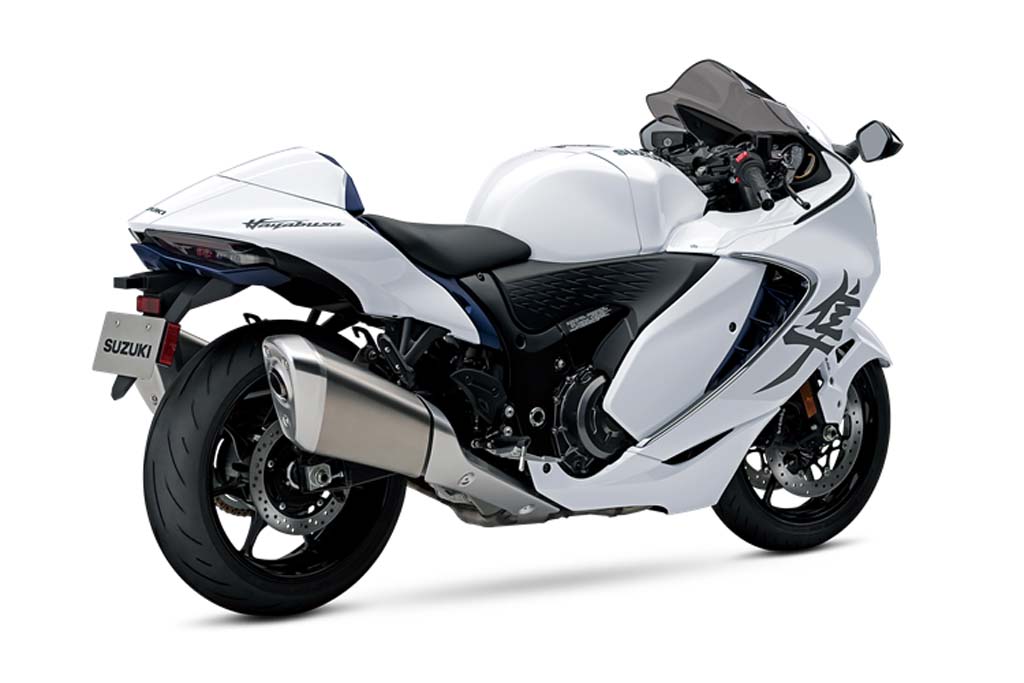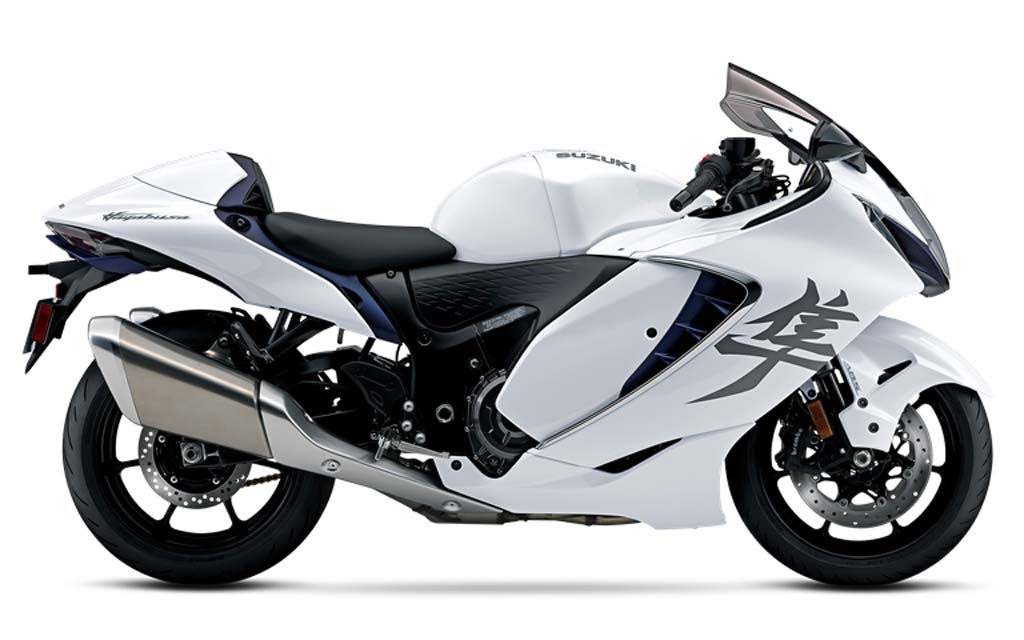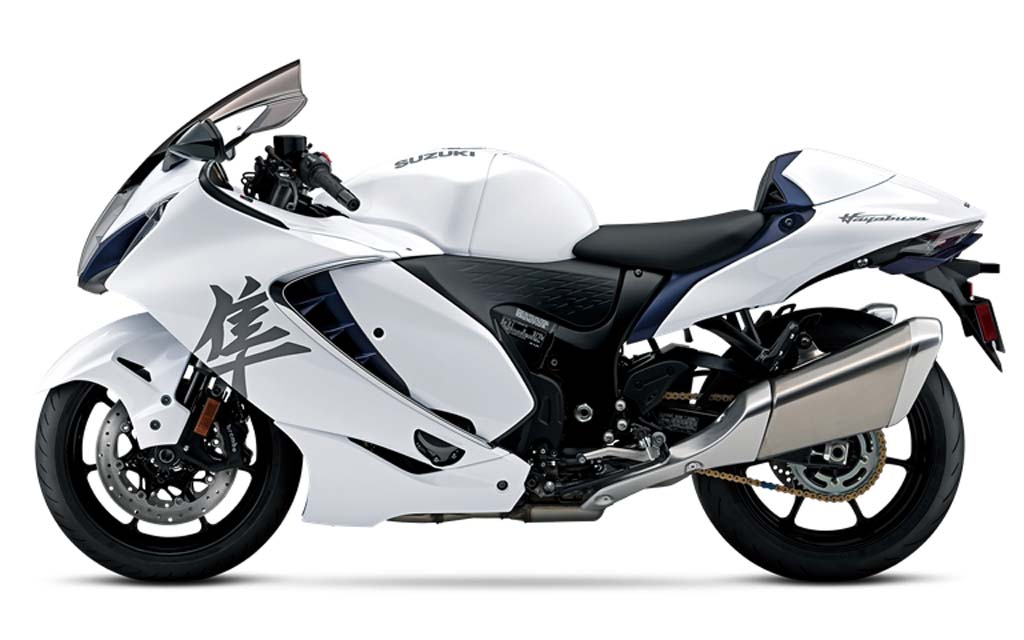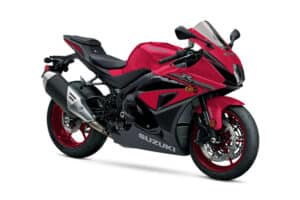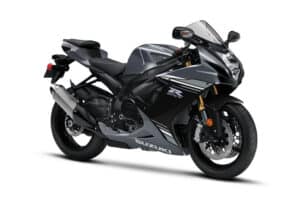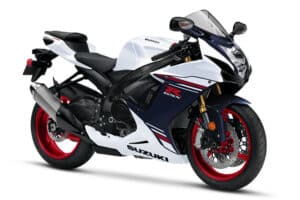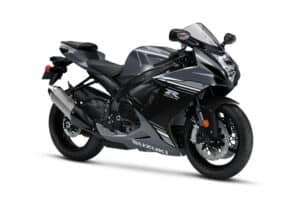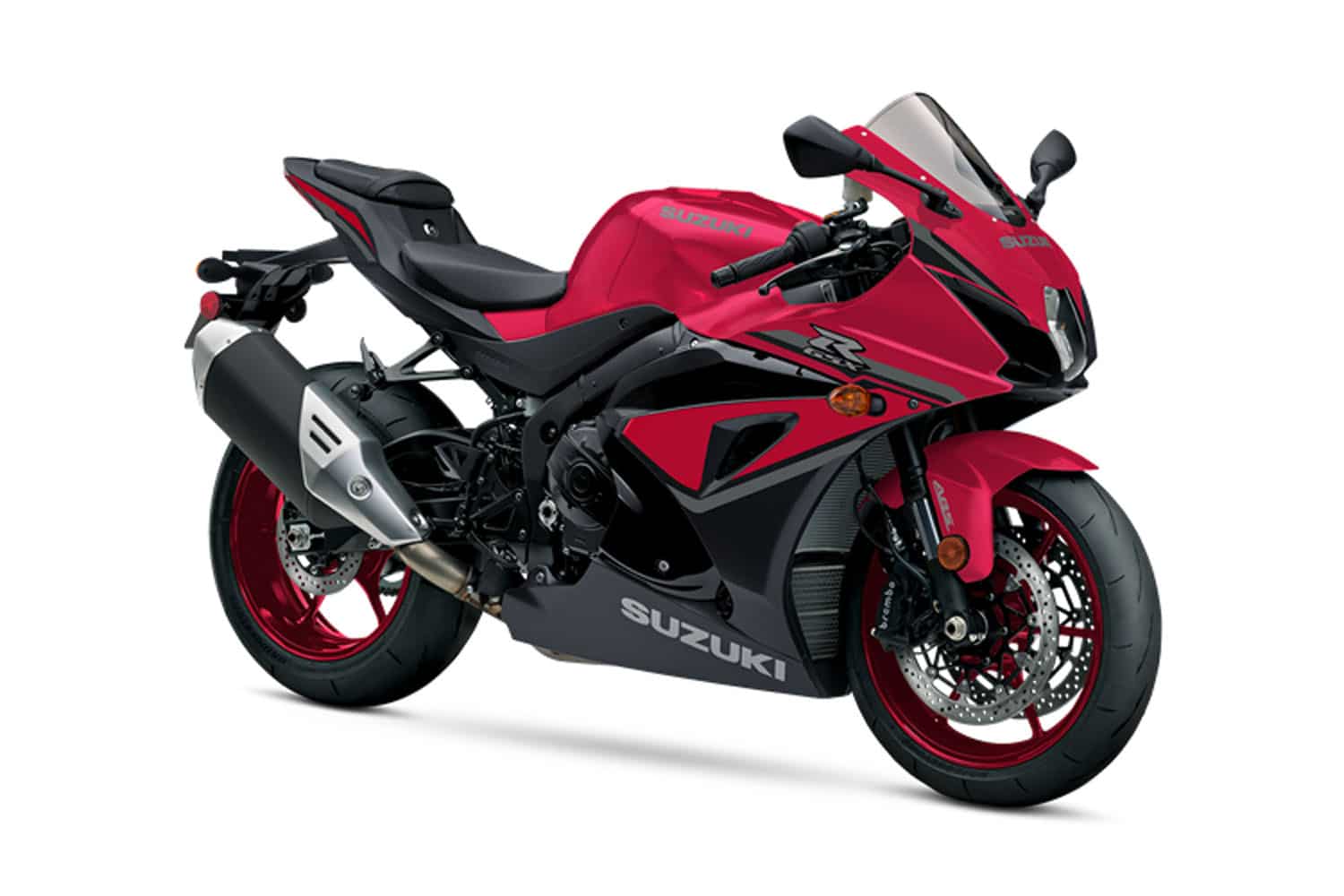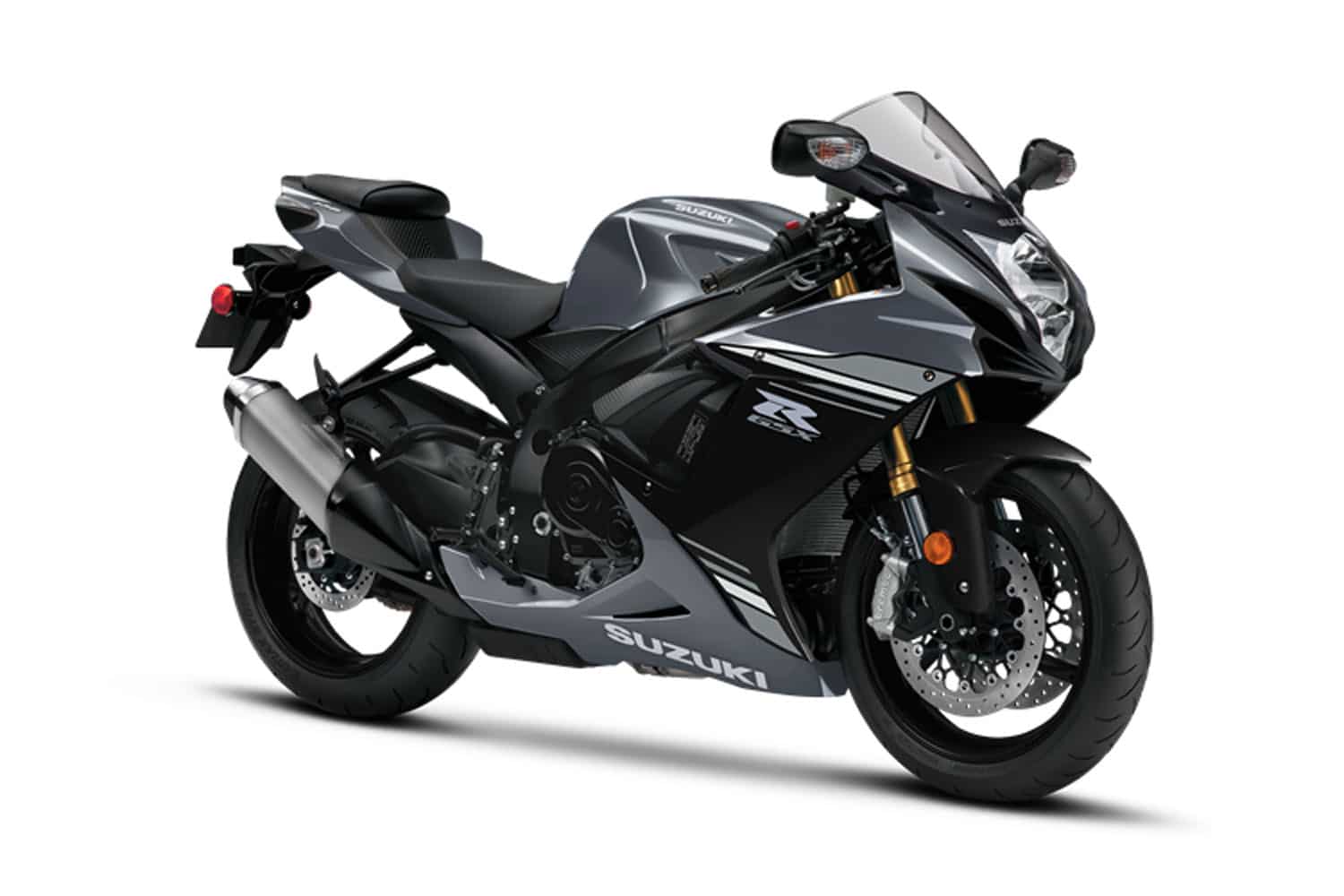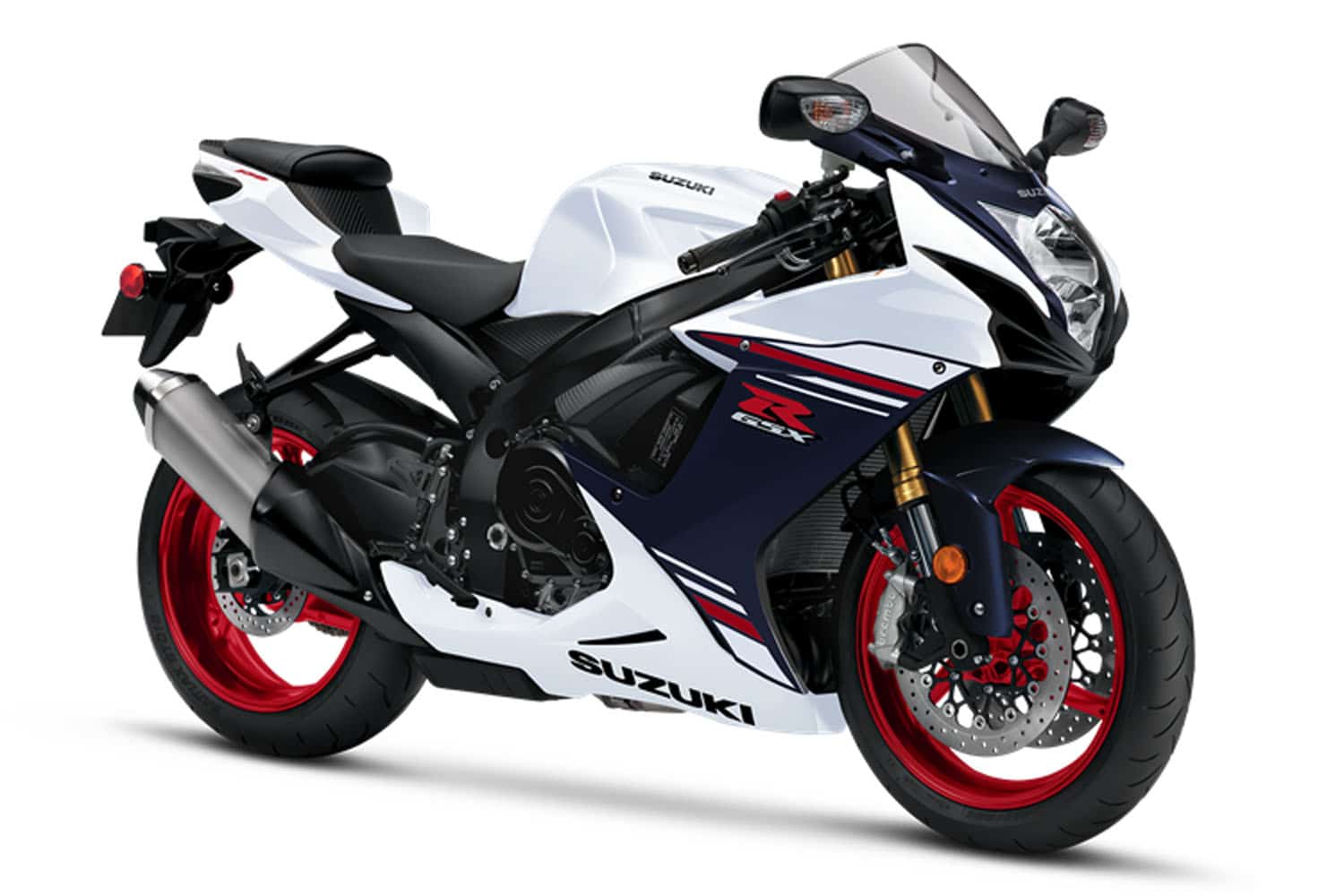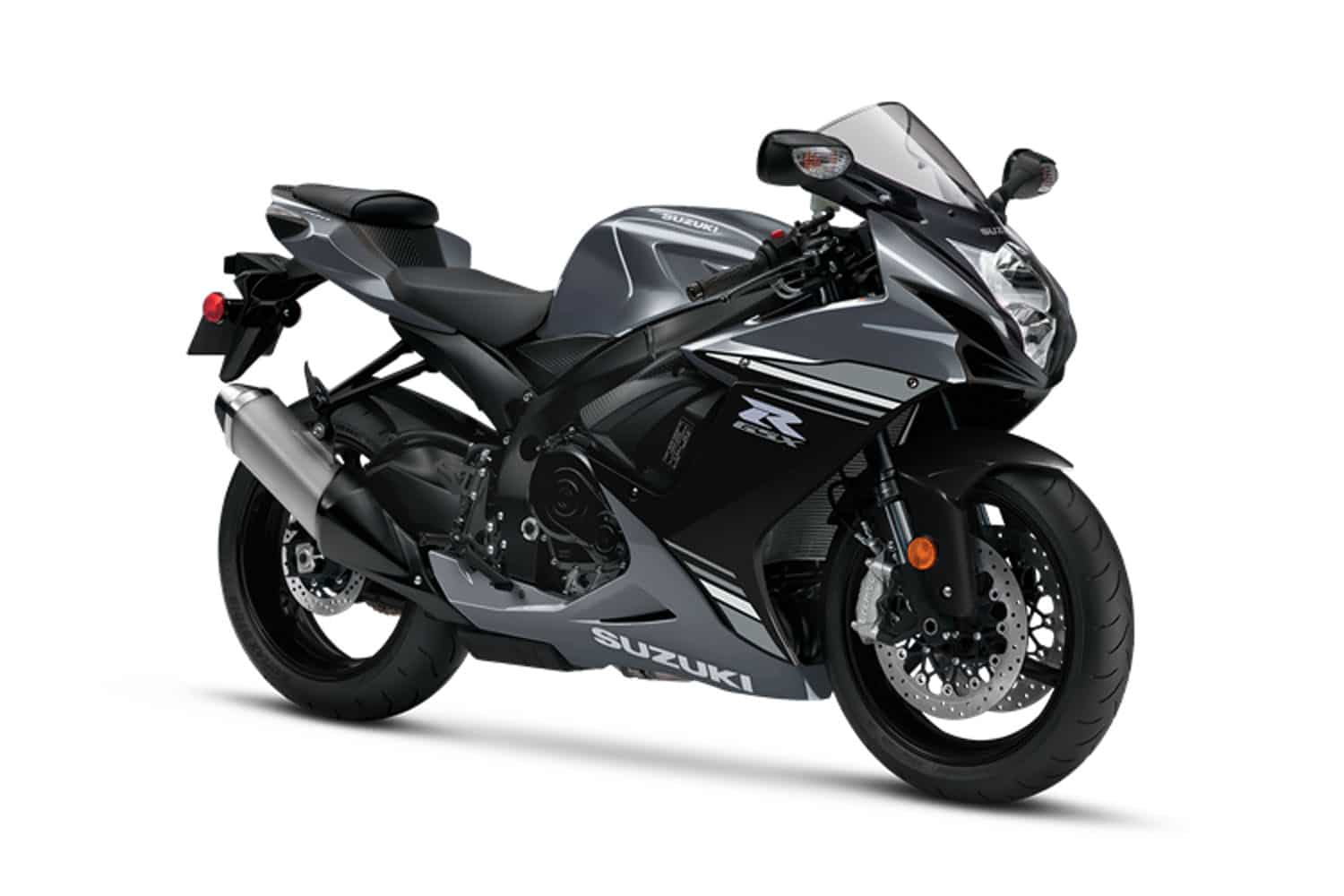The 2021 Suzuki Hayabusa reaffirms its status as motorcycling’s Ultimate Sportbike. This new generation of Suzuki’s flagship sportbike is propelled by a muscular, refined inline four-cylinder engine housed in a proven and thoroughly updated chassis with incomparable manners, managed by an unequaled suite of electronic rider aids within stunning aerodynamic bodywork that is distinctly Hayabusa.
Riders who have owned or longed for a Hayabusa will recognize the iconic, aerodynamic silhouette that has been polished through wind tunnel sessions so the body features new vent shapes, air diffusers, and reimagined logos while a sophisticated LED lighting system achieves a new zenith of style and function.
Engine performance has been broadened so the Hayabusa accelerates quicker and smoother than ever before, while complying with worldwide emissions standards. Rider control is expanded through the 2021 Suzuki Hayabusa Suzuki Intelligent Ride System (S.I.R.S.). The engine’s adjustable power delivery, traction control*, cruise control, launch control, quick shift and Motion Track ABS** and Combined Brake systems offer the Hayabusa rider unmatched options on how the ride will unfold.
The 2021 Hayabusa has 550 new or redesigned parts, all with a focus on delivering the ultimate and balanced sportbike experience. Motorcycle history repeats itself as all eyes turn to the Suzuki Hayabusa; another testament to Suzuki’s century of dedication to creating art while building the best performing product that is unmatched in quality, reliability and value. The Hayabusa, like its namesake peregrine falcon, soars above all once again.
2021 Suzuki Hayabusa Features
Key Features
The Hayabusa remains instantly recognizable as its restyled, wind-cheating body retains the cues that were inspired by the peregrine falcon – the world’s fastest animal. To bring a sophisticated appearance to the iconic Hayabusa, Suzuki’s design team incorporated distinct lines and shapes to achieve an expression of refinement and ultimate performance.
For 2021, riders may choose from Glass Sparkle Black & Candy Burnt Gold, Metallic Matte Sword Silver & Candy Daring Red, or Pearl Brilliant White & Metallic Matte Stellar Blue paint schemes. Each scheme features restyled Hayabusa Kanji symbols and model name logos.
Fully reengineered, the Hayabusa’s legendary 1340cc, four-cylinder, DOHC engine is fed by new Ride-by-Wire electronic throttle bodies with dual fuel injectors feeding each cylinder, mixing with pressurized air from the Suzuki Ram Air Direct (SRAD) intakes in the nose of the aerodynamic fairing. The new, symmetrical twin silencer exhaust system is lighter with better flow and a stimulating exhaust note.
Enhancements to the Hayabusa’s superbike-caliber, twin-spar aluminum frame result in a more stable ride with nimble handling that can be personalized through the adjustable KYB-supplied suspension. Optimized aerodynamics and wind protection provide comfort while improved braking performance inspires rider confidence.
The Hayabusa employs an advanced version of the Suzuki Intelligent Ride System (S.I.R.S.); a comprehensive collection of electronic rider aids like Cruise Control and Bi-directional Quick Shift systems that can optimize and personalize the motorcycle’s performance characteristics to match the conditions and desires of the rider. Only the Hayabusa offers this premium suite of aids that simultaneously boosts performance and comfort as riders enjoy the ultimate sportbike experience.
Engine
The powerful, 1,340cc, inline-four-cylinder, liquid-cooled, DOHC engine has been fully revised to supply a seamless surge of torque for effortless acceleration.
Using techniques developed for the GSX-R1000, the redesigned crankcases have new lubrication passages for 54% more oil flow to the crankshaft for increased durability.
The crankcase assembly hardware and tightening procedure is also revised to increase engine rigidity and durability.
U-shaped cutouts in cylinder’s bores allow crankcase pressure created by descending pistons to escape to adjacent cylinders to reduce internal pumping pressure and mechanical power losses.
Suzuki Composite Electrochemical Material (SCEM) cylinder coating improves heat dissipation, durability, and ring seal. The three-ring, aluminum-alloy slipper pistons have a new shape and lightweight design (reducing the weight of each piston by 26 grams). Conical machining at the piston pin bores improves strength and durability.
The chrome nitride Physical Vapor Deposition (PVD) piston ring coating is harder and smoother than conventional chrome plating, reducing friction while improving sealing to the SCEM-coated cylinder.
Like the crankcase, the crankshaft has been revised with new oil passages to increase lubrication at several key areas.
The connecting rods have a new design that reduces weight (by 3 grams each rod) while increasing rigidity.
The combined, lighter weight of the new crankshaft, connecting rods and pistons reduce internal vibration, which in turn contributes to greater engine durability.
A gear-driven balancer shaft is timed to the crankshaft to help minimize vibration to the engine and the rider.
The design of the Twin Swirl Combustion Chamber (TSCC) in the cylinder head is changed to promote faster and more efficient burning of the fuel-air mixture. The change complements other valve train updates, increasing flow coefficient by 5% to improve combustion efficiency.
The exhaust camshaft’s lift has been increased and timing for both camshafts has been updated to reduce valve opening overlap, boosting low- to mid-range engine performance. Camshaft’s lobe width is increased, improving valve train lubrication and durability.
Lightweight titanium valves with new, higher rate valve springs match the camshaft changes to maintain accurate valve control.
The cam chain tensioner was redesigned to minimize chain runout and includes a new Teflon coating on the slipper surface to reduce mechanical loss.
Fired by independent ignition coil-caps in each cylinder, iridium spark plugs produce more complete combustion and last longer than conventional plugs.
A curved radiator with a compact, dense-core design and two ECM-controlled electric fans keep the engine temperature stable.
Changes to the Hayabusa’s body permits higher air flow through the radiator, increasing cooling efficiency. The air flow is increased by 8% when the Hayabusa is in motion and approximately 7% when the cooling fan is moving air during low- to mid-speed riding.
To allow the cooling fans to spin down when stopping in traffic, reducing warm air flow to the rider, the cooling fan blade pitch is improved and the fan shroud size is reduced.
Positioned below the main radiator, a large-capacity air-cooled oil cooler reduces engine oil temperatures throughout the crankcase.
The Hayabusa is now equipped with Suzuki’s Ride-by-Wire Electronic Throttle body system which provides a light, natural response with linear control similar to that of a conventional throttle.
The electronic throttle bodies have tapered 43mm bores and are part of a new intake system (intake pipe, throttle body and air cleaner funnel) that is 12mm longer than the prior generation Hayabusa to boost power at low-to mid-range engine speeds.
Because the ECM controls the action of the throttle bodies, other functions are added or improved; including cruise control, launch and lift control, the bi-directional quick shift system, cold-start up and idle speed control, and simplified service procedures.
The new throttle bodies incorporate four primary fuel injectors that spray a fine mist of fuel directly into the intake pipes. Four additional Suzuki Side Feed Injectors (S-SFI) are set above the throttle body in the side of the intake funnels. These side injectors spray a fine mist of fuel on a reflecting plate at the top of the throttle body, resulting in a 2% increase in power and torque output in the low- to mid-range.
The new throttle bodies made it possible to increase the air cleaner assembly’s capacity from 10.3 liters to 11.5 liters, increasing the air supply to the engine. The air cleaner has a more rigid lid and simplified internal structure that also enhances the intake air sound quality.
The two Suzuki Ram Air Direct (SRAD) intake ducts in the upper fairing route high-pressure, fresh air to the air cleaner boosting performance in a linear fashion as the road speed increases.
Flow analysis was employed when developing the SRAD ducts on the new Hayabusa. The new design reduces pressure loss and increases the flow of pressurized air to the air cleaner while contributing to smoother aerodynamics and a more exciting intake sound.
Suzuki Pulsed Secondary Air Injection (PAIR) system introduces fresh air into the exhaust to ignite unburned hydrocarbons (HC) to reduce carbon monoxide (CO) emissions.
The exhaust system is a fresh design that is 4.5 pounds (2,054 grams) lighter with newly styled silencers that complement the Hayabusa’s look. The silencers also have more capacity for better performance and have been tuned to emit a more exciting sound off idle and at lower speeds.
The new four-into-two-into-one-into-two exhaust system configuration uses a new pipe connecting the #1 and #4 head pipes to help deliver more power and torque at low- to mid-range speeds. Like the prior generation exhaust, a connector pipe connects the #2 and #3 head pipes for similar benefits.
The new exhaust has high-flow catalyzers in the mid-pipe and within each silencer to further reduce HC, CO, and nitrogen oxide (NOx) emissions. Dual O2 sensors provide instantaneous feedback to the ECM for smooth, clean EFI operation.
The body of the exhaust silencers (mufflers) will change in color and hue over time in response to the way the bike is ridden. This makes it possible for each rider to add a unique personal touch to his or her Hayabusa.
Driveline Features
The Hayabusa’s six-speed, close-ratio, and constant-mesh transmission can be shifted conventionally or with the new bi-directional quick shift system allowing the rider to select racing-style, conventional, or casual riding clutchless shifts.
The Hayabusa has a new version of the Suzuki Clutch Assist System (SCAS) clutch that delivers a lighter clutch lever pull than ever before. SCAS serves as a back-torque-limiting system for smooth downshifts while increasing plate tension during acceleration to ensure engine power is effectively transmitted to the rear wheel.
Hydraulic clutch activation further reduces the lever pull while providing the rider a good sense of the clutch’s friction zone.
In conjunction with the new crankcase the Hayabusa’s six-speed, close-ratio transmission has been refined to match the engine’s performance while improving durability and simplifying service.
Oil jets in the crankcase spray lubricating oil on the fourth, fifth, and sixth gears to reduce friction, wear, and mechanical sounds during high-speed operation.
The length of the countershaft is increased to accommodate the new SCAS-style clutch and longer needle bearings to increase durability. The clutch pushrod length is also increased to match the countershaft change.
The gearshift cam, end plate and stopper are redesigned to better function with the quick shift system while still proving the rider a smooth and direct shift feel.
A new transmission retainer system is employed to simplify service.
Developed for the Hayabusa, the unique and strong RK GB50GSVZ4 drive chain has larger pins and rollers for reliable and quiet operation.
Chassis Features
The Hayabusa’s twin-spar aluminum frame and swingarm incorporate aluminum castings along with extruded aluminum sections that provide the right amount of suppleness and strength to its overall rigid alloy frame structure.
Weighing 1.5 pounds (700 grams) less than the prior generation’s part, the redesigned sub-frame is made of longer rectangular steel tubing for ample weight-carrying capacity.
The KYB inverted cartridge fork is also updated, with a revised internal structure offering more compliance to further improve the suspension’s ability to absorb shocks from the road helping to ensure a smoother, more stable ride with optimum grip.
The fork has spring preload plus rebound and compression damping force adjusters so the rider can tune the suspension response to their preference.
The fork’s 43mm inner tubes feature Diamond-Like Carbon (DLC) coating to reduce friction and improve reaction to small road surface irregularities.
Like the fork, the internal structure of the KYB rear shock absorber was also revised to help optimize comfort and straight-line stability.
The shock absorber has threaded spring preload adjustment collars plus rebound and compression damping force adjusters.
A steering damper attached to the frame and the lower fork bracket provides damping force to suppress unwanted vibration and steering forces, but is tuned to provide a light steering feel at lower speeds.
New seven-spoke cast aluminum alloy wheels help improve grip and feel to the rider while matching the Hayabusa’s exciting styling.
Co-developed by Suzuki and Bridgestone, the Hayabusa is shod with the new Battlax Hypersport S22 tires in120/70ZR17M/C (58W) front and 190/50ZR17M/C (73W) rear sizes.
These Bridgestone tires use a new compound and construction to help improve grip on dry roads, performance in wet conditions, and help provide greater all-round agility. The S22 tires also provide excellent straight-line stability and braking grip, providing the rider a more exciting and confidence-building experience.
The Hayabusa provides the rider extraordinary control of braking with the Combined Brake System, and the Motion Track Antilock Brake System (MT-ABS)**.
- With the Combined Brake System the rider can operate the brake with more confidence as operating the front brake lever will provide braking power to both the front and rear brakes.
- The new, advanced design ABS-unit has a lightweight, compact design. Antilock brakes enhance braking performance by helping prevent, to a certain extent, wheel locking due to changes in road conditions or excessive braking by matching stopping power to available traction.
- This ABS-unit combines IMU-measured, spatial information of the motorcycle’s posture in conjunction with front and rear wheel speeds. This allows the MT-ABS** to not only activate in a straight line but also when the vehicle is leaning or turning.
- See other brake system-related features in the Suzuki Intelligent Ride System (S.I.R.S.) section.
The Hayabusa adopts the innovative Brembo Stylema front brake calipers. Featuring a lighter, more compact and carefully sculpted design that is intended for use on high-performance motorcycles, these new calipers increase airflow around the brake pads to cool more quickly and deliver immediate response.
The Stylema front brake calipers are paired with a pair of stainless-steel full-floating discs with a diameter increased from 310mm to 320mm and feature a new hole pattern that further helps optimize cooling efficiency.
The solo rear 260mm brake rotor is grabbed by a single-piston brake caliper.
The new floating handlebar mount helps minimize vibration, while visual changes to the design match the Hayabusa’s premium sportbike status.
The handlebars are mounted 12mm closer to the rider vastly improving comfort and reduce fatigue when touring while enhancing control.
The rider footrests have damped mounting hardware to reduce vibration and are set in a sporty, yet comfortable relationship to the handlebars and seat. The heel guards incorporate replaceable plastic inserts that can be changed to renew their appearance.
Both the shift and rear brake levers are easily adjustable to the rider’s preference.
The Hayabusa’s black-anodized, adjustable clutch and front brake lever have carefully crafted shapes to aid rider control and feature slots at the ends to reduce the chance of wind pressure pushing the levers inward.
Thanks to the new bodywork and sub frame, the Hayabusa’s seat height is reduced to 31.5 inches.
The rear seat is set higher than the front seat so the passenger can enjoy a forward view over the rider’s shoulder.
Visually matching the Hayabusa’s styling, the grab rail is reshaped and set in proximity to the rear seat so it is easy for the passenger to grasp.
The passenger seat and grab rail can be replaced by an optional, color matched single seat cowl that acts as a lumbar stop for the rider during solo rides while adding to the Hayabusa’s performance-related style.
**Depending on road surface conditions, such as wet, loose, or uneven roads, braking distance for an ABS-equipped vehicle may be longer than for a vehicle not equipped with ABS. ABS cannot prevent wheel skidding caused by braking while cornering. Please ride carefully and do not overly rely on ABS.
Body & Styling Features
The styling of the bodywork intentionally conveys a modern image of advanced performance and new features, while faithfully inheriting the wind-cutting silhouette and overall look for which the Hayabusa is famous.
From every angle and in every detail, the Hayabusa’s body features straighter, sharper lines that create a firm impression of modern appeal that is sure to turn heads.
- These lines trace from the front fairing and fuel tank through to the tail section, projecting the aura of high quality and luxury.
- These lines also sweep to the new, slimmer exhaust silencers. The silencers combine with the sharp new upswept tail design to further emphasize the Hayabusa’s aggressive performance stance.
- Adding cleanliness and flair to the Hayabusa’s bold tail is a sharp, wide new LED rear combination light (that incorporates running, brake and turn signal functions).
Beyond art, the bodywork was also developed by practical shaping during extensive wind tunnel developmental sessions so the Hayabusa’s advanced aerodynamics offer superb wind protection both for normal and completely tucked-in seating positions.
- More than a styling exercise, the Hayabusa features one of the best drag coefficients found on any street legal motorcycle, while also achieving excellent CdA and lift values to help maximize top speed potential and stability at top speed.
- The 2021 Suzuki Hayabusa vertically stacked headlight continues to be a bold styling feature that increases performance as its location between the large Suzuki Ram Air Direct (SRAD) intake ducts provides high pressure air at speed that boosts engine power.
- Flanking the SRAD ducts are new position lights with integrated turn signals. They form a single clean vertical line that flows back along the cowling and eliminates the bulbous turn signal shape of the previous generation.
- The V-shaped chrome-plated moldings in front of the air ducts on the side cowlings create a styling accent flowing from the engine to the mufflers that visually expresses the immense amount of power emanating from the engine, but are also functional parts that draw wind away from the rider’s legs.
- Complementing the slippery styling is a new aerodynamic windscreen that is shaped to reduce the wind blast to the rider while permitting a good view of the instrument cluster. A Suzuki Genuine Accessory windscreen that is 1.5 inches (38mm) taller is also available.
- The black plastic accent pieces that extend from the sides of the upper cowl near the handlebars deflect air away from the rider’s elbows and knuckles.
- New streamlined mirrors have been positioned low and outward to provide an excellent rear view to the rider.
The new generation Hayabusa debuts with a trio of two-tone body colors:
- Glass Sparkle Black & Candy Burnt Gold uses splashes of gold to create impact and add a touch of luxury. The contrast of gold on black is inspired by fine Japanese lacquer ware.
- Metallic Matte Sword Silver & Candy Daring Red deftly leverages splashes of red to create a visual expression of hidden power. The silver represents a futuristic image and expresses intelligence.
- Pearl Brilliant White & Metallic Matte Stellar Blue uses blue as the accent color that represents the spirit of Suzuki.
The Hayabusa kanji and name logos have been restyled to align with the new bodywork’s modern look. Both logos adopt highly stylized strokes and the name logo features a long cross stroke on the “H” that emphasizes a sense of speed.
Small, tasteful versions of the Hayabusa’s Japanese logo are incorporated on the ignition key fob, within the LED headlight housing, at the front of the accessory seat cowl, and is visible as part of the start-up animation on the instrument cluster’s TFT display.
Electrical & Lighting Features
Riders adore the outstanding functionality and familiar layout of the Hayabusa’s instantly recognizable instrument cluster. Continuing the tradition of blending analog gauges with digital LCD displays and LED icons, the new Hayabusa’s instrument cluster benefits from a number of carefully developed improvements and valuable features with styling to match the bike’s modern appearance.
- The large analog tachometer and speedometer have a fresh, more attractive appearance that includes larger and bolder numbering that improves readability. Raised scale markings around the periphery of each gauge use LED lighting to provide a clearer view and faster recognition in both daylight and night.
- Carrying the theme of gold colored accents throughout the cockpit area, the analog fuel and coolant temperature gauges that flank the speedometer and tachometer are ringed in gold, as are the SDMS-a and Active Data display screens on the new Thin Film Transistor (TFT) and Liquid Crystal Display (LCD) panel.
An exceptional new feature of the instrument cluster is the TFT LCD panel centrally mounted between the speedometer and tachometer. By using two display methodologies, the TFT LCD panel can display a variety of information in formats that are easily recognizable and attractive.
- The TFT LCD panel displays either the current SDMS-α systems settings or an Active Data display that shows lean angle (with a peak-hold function), front and rear brake pressure, rate of vehicle acceleration or deceleration, and the current accelerator position.
- The panel also shows the time, gear position, odometer, dual trip meter, ambient air temperature, instantaneous fuel consumption, riding range, trip time, average fuel consumption, and battery voltage displays.
- LEDs located in the corners above and below the TFT LCD include the neutral indicator light, turn-signal indicator lights, high-beam indicator light, low oil pressure warning light, TC (Traction Control) indicator, MIL (Malfunction Indication Lamp), master warning indicator, and ABS indicator. There is also an LED engine coolant temperature indicator light in the upper right corner of the engine coolant temperature gauge and fuel indicator light in the upper left corner of the fuel meter gauge.
- An additional feature of the LCD panel is a brief animation of the Hayabusa kanji character that plays when the ignition key is turned on. This playful presentation is pleasing to the eye and heightens anticipation of the ride to come. A second animation featuring the Suzuki logo plays before the display is turned off.
An ambient light sensor automatically adjusts the instrument cluster’s brightness level based on surrounding conditions, but the rider can manually adjust the illumination to their preference.
Newly designed handlebar switches are laid out to maximize operating ease and efficiency. The mode/set switch on the left handlebar controls various Suzuki Intelligent Ride System (S.I.R.S.) settings and adjustments, including cruise control operation.
- The rider can use the instrument cluster information and the rocker switch on the left handlebar control to change the TFT LCD display and S.I.R.S. settings.
- The right handlebar switch has a poly-function rocker switch that is the engine stop and start button that activates the Easy Start System. A single button below the rocker switch engages the cruise control.
A new dual-core 32-bit ECM provides state-of-the-art engine management that contributes to the operation and optimization of the Hayabusa’s electrical and S.I.R.S. components.
Key to the operation of Hayabusa’s S.I.R.S. and other electrical features is a Computer Area Network (CAN) style wire harness that functions as an interconnected information network rather than using a more complex and slower conventional wiring harness.
- The robust CAN-wiring system enables the motorcycle’s various sensors and microcontrollers to instantaneously communicate with each other.
- Because it requires fewer wires, this CAN-wiring lets the vehicle be lighter and simpler, and provides a way for the advanced components – such as the electronic throttle bodies and cruise control – on the motorcycle to have faster data transmission with the ECM.
- The CAN-wiring also provides a single location for diagnosing any errors that may occur throughout the entire network.
The 400W charging system uses a durable, oil-cooled three-phase stator. A high-capacity, maintenance-free style battery and fuses are easily accessible under the rider’s seat.
Another component supporting S.I.R.S. and other Hayabusa technology is a new six-direction, three-axis Inertial Measurement Unit (IMU) supplied by Bosch.
- The Hayabusa’s new IMU measures six directions of movement along three axes. The IMU detects pitch, roll, and yaw movement based on the motorcycle’s position, movement, and acceleration.
- This new high-performance six-direction IMU also combines a three-axis angular rate sensor (gyro meter) and a three-axis acceleration sensor in a single compact unit.
The Hayabusa is equipped with the latest compact Antilock Brake System (ABS) unit from Bosch. Working in conjunction with the new IMU, the ABS-unit realizes features such as the Motion Track Brake System, Slope Dependent Control System and Hill Hold Control System.
Befitting its premium sportbike status, the new Hayabusa is equipped with highly functional and attractive lighting. The stacked headlight format that debuted with the original Hayabusa continues in this new generation with advanced technology and modern styling.
- Both the low beam and projector-type high beam headlights use bright LEDs that provide clear illumination and help make the Hayabusa clearly visible to pedestrians and other traffic at night.
- Attention to achieving a memorable look extends to every detail. The two upper and two lower LEDs for the low-beam are mounted in the corners where they shine across a reflector panel and fill the light assembly with attractive illumination. Fine touches throughout the headlight assembly include the use of black parts that heighten the sharp looks, as well as the inclusion of the Hayabusa kanji character on top of the black cowl above the high beam lamp.
- Hayabusa’s front turn signals are incorporated in the position lights, a first for a Suzuki motorcycle.
- This new design integrates the LED position lights and turn signals into single assemblies that neatly flank the outer edges of the large SRAD air intakes.
- An illumination scheme using white lighting for the position light with the turn signals flashing in orange when signaling creates a unique overall effect that heightens the sense of a luxurious riding experience.
Suzuki Intelligent Ride System (S.I.R.S.) Features
1. Control of the Engine Output Characteristics
- The Suzuki Drive Mode Selector Alpha (SDMS-α) system provides the rider a choice of three factory preset and three rider (or user) defined and combined settings of the Power Mode Selector, Motion Track Traction Control, Anti-lift Control, Engine Brake Control and Bi-directional Quick Shift systems.
- These presets provide the rider a quick and easy way to set the Hayabusa’s performance characteristic to their liking.
- Three factory preset modes (A, B, and C) have been carefully created so the SDMS-α can set S.I.R.S. for optimal performance.
- Factory preset mode A is for active, sporty use.
- Factory preset mode B is for general, all-around riding
- Factory preset mode C is for comfort and touring.
- The rider can create three user-defined settings (U1, U2, and U3). These unique setting allow the rider to tune S.I.R.S. to their riding style or to their favorite road. It is then a quick and easy process for the rider to set the S.I.R.S. to use those settings.
- Using the mode and select switches on the left handlebar the rider can change modes and settings that are then displayed on the TFT LCD panel located at the center of the instrument cluster.
- The Power Mode Selector (PW) permits selection between three different engine output characteristic modes to match the riding conditions or the rider’s preference.
- Mode 1 provides the sharpest throttle response up to maximum engine power.
- This characteristic would be well suited for use by experienced riders riding on good road conditions.
- Mode 2 provides a softer throttle response with a more linear power delivery up to maximum engine power.
- This characteristic would be well suited for use by most riders riding on average road conditions.
- Mode 3 provides the softest throttle response with a more gentle power curve with reduced maximum output.
- This characteristic would be well suited for riders with less experience or by all riders riding on poor road conditions (wet or dirty surface with limited traction).
2. Control of the Engine Acceleration Characteristics
- The Motion Track Traction Control System (TC) was designed to provide greater stability and help enable the rider to control the Hayabusa with confidence in varying riding conditions by limiting rear wheel spin.
- Adopted directly from the traction control system Suzuki developed for MotoGP racing, the Hayabusa’s TC system features smooth control that does not interfere when enjoying a more aggressive, sporty ride.
- The TC system offers 10 mode settings and can also be switched off. The higher the mode number the more the system is sensitive to rear wheel spin and the faster it will intervene, limiting wheel spin.
- The ECM continually monitors front and rear wheel speed, engine RPM, plus throttle position and gear position, and lean angle data from the IMU. When the system determines that loss of traction is imminent, the ECM adjusts engine power to prevent wheel spin.
- The TC modes are displayed on the TFT LCD display and can be changed on-the-fly using the left handlebar switch. When the system is trimming power to prevent wheel spin, the TC icon in the center of the instrument cluster will illuminate and flash.
- The Anti-lift Control System (LF) adds control reassurance to riders by helping prevent the front wheel from lifting off the ground when accelerating.
- The rider can choose from 10 modes, or turn the system off. The higher the setting, the greater the amount of control supplied. When in Mode 10, for example, it is virtually impossible to lift the front wheel, even with a passenger on the back and the throttle wide open.
- Hayabusa’s dual-core 32-bit ECM processes data such as engine speed, throttle position, gear position, clutch switch and front and rear wheel speed sensors, as well as the IMU, to determine the appropriate amount of engine output to deliver in response to the rider operating the throttle and the LF system mode setting.
- The LF mode settings are displayed on the TFT LCD display and can be changed using the left handlebar switch.
- The Launch Control System (LC) helps ensure efficient launch and acceleration from a standing start. Launch Control for the Hayabusa offers three modes from which the rider can choose to match his or her level of experience or confidence.
- LC Mode 1 limits engine speed on launch to 4,000 RPM for smooth, softer acceleration from a stop.
- LC Mode 2 lets the engine rev to 6,000 RPM for a moderate, stronger acceleration characteristic from a stop.
- LC Mode 3 limits the engine speed to 8,000 RPM for the strongest and quickest acceleration from a stop.
- The LC mode settings are displayed on the TFT LCD display and can be changed using the left handlebar switch.
3. Control of the Engine Deceleration Characteristics
- The Engine Brake Control System (EB) is a new three mode (and OFF setting) system that provides control over the effective strength of engine braking to match the rider’s preference.
- The higher the setting, the more the system provides the rider with smoother, more controllable behavior by cancelling out the effect of engine braking to help eliminate rear tire sliding or skipping when decelerating after releasing the throttle grip or downshifting.
- The rider can also switch EB off to experience the full effect of the engine braking during deceleration.
- The EB mode settings are displayed on the TFT LCD display and can be changed using the left handlebar switch.
4. Control over the Engine at Steady Speeds
- The Hayabusa’s Cruise Control System maintains the selected road speed without the rider having to hold the throttle open – a welcome feature for long-distance riding that can reduce rider fatigue.
- Cruising speed can be set from approximately 20 MPH to 125 MPH (31 km/h to 200 km/h) while riding at 2,000 to 7,000 RPM is second gear or higher.
- The cruise speed setting appears on the TFT LCD display and a button on the right handlebar control can be pressed to activate or put the cruise control into standby.
- The rocker-style mode-selector switch on the left handlebar control lets the rider adjust the speed up or down, and a handy resume function re-engages the system and accelerates to the most recent speed setting after canceling.
- Suzuki’s Active Speed Limiter is a first in the motorcycle industry, as this highly practical system allows the rider to set a speed limit the bike will not exceed, eliminating concerns about speeding or driving faster than intended.
- With the Active Speed Limiter engaged, the rider can accelerate freely up to the preset speed, but not exceed it. The rider can decelerate normally by backing off the throttle.
- The system can be temporarily overridden with one quick twist of the throttle, making it easy to accelerate beyond the set limit to pass other vehicles. It can be deactivated completely at the press of a button after releasing the throttle grip.
5. Control over Engine Operations
- The dual mode Bi-directional Quick Shift System (QS) allows the rider to shift up or down quickly and easily, without operating the clutch or throttle. To ensure smooth upshifts QS adjust ignition timing when accelerating or riding at a steady speed. When decelerating, QS adjusts throttle settings, automatically blipping the throttle when downshifting.
- QS Mode 1 reacts quickly to the rider moving the shift lever to replicate a racing-style response.
- QS Mode 2 offers a lighter reaction to the rider’s shift that is well suited for casual riding.
- Performance of the Hayabusa’s new SACS-style assist & slipper clutch ensures even smoother up and down shifts when using QS or manual clutch operation.
- The Suzuki Easy Start System lets the rider start the motorcycle with a momentary press of the starter button. There is no need to pull in the clutch lever when the transmission is in neutral, and the starter motor automatically disengages the instant the engine fires up.
- The Low RPM Assist System seamlessly increases engine speed to smooth the power delivery when launching from a standing start or riding at low speeds to help ensure better control and operation in stop-and-go traffic. The system also minimizes the possibility of the rider stalling the motorcycle during take-off.
6. Control over Braking
- The Combined Brake System provides stopping confidence to the Hayabusa rider as operating the front brake lever provides braking power to both the front and rear brakes.
- Using the brake pedal (with the right foot) operates the rear brake only.
- The Motion Track Anti-lock Brake System (MT-ABS) combines IMU-measured, spatial information of the Hayabusa’s posture in conjunction with front and rear wheel speeds. This allows the ABS** to not only activate in a straight line but also when the vehicle is leaning or turning.
- By reducing the impact of sudden braking force, the Hayabusa is less likely to try to push itself upright or lose traction, instead maintaining the turning radius and lean angle to better follow the rider’s intended line through the corner.
- Even if the rider is startled and brakes heavily in a corner, MT-ABS assists in helping maintain stability while stopping or slowing the motorcycle.
- The MT-ABS system cannot be switched off – it is always active.
- The Slope Dependent Control System prevents rear wheel lift when braking when travelling downhill. The ABS unit continually measures brake pressure while the IMU constantly monitors vehicle posture of the vehicle even as the Hayabusa is traveling downhill. When the rider operates a brake lever or pedal when riding downhill, the electronic control unit adjusts brake pressure to prevent rear wheel lift, providing more stable braking.
- The Hill Hold Control System helps hold the Hayabusa when it is stopped on an incline, providing confidence so riders can focus on smoother takeoffs up the hill.
- When stopping upward on a hill and applying the brakes, this system automatically operates the rear brake for around 30 seconds to prevent the motorcycle from rolling back down the hill even if the rider releases the brake lever or pedal.
- When the rider releases the brake lever or foot pedal, the ECM detects the rider’s intention to ride forward and releases the rear brake pressure smoothly.
- The rider can also disengage the Hill Hold System by squeezing the front brake lever twice or use the left handlebar control and the instrument cluster with the system off.
- An “H” mark lights on the instrument cluster when the system is engaged, and flashes when the system is disengaged.
2021 Suzuki Hayabusa Specifications
Colors
Glass Sparkle Black & Candy Burnt Gold (B5L)
Metallic Matte Sword Silver & Candy Daring Red (B5M)
Pearl Brilliant White & Metallic Matte Stellar Blue (B5N)
Engine
Engine: 1340cc, 4-stroke, liquid-cooled, 4-cylinder, DOHC
Bore x Stroke: 81.0 mm x 65.0 mm (3.19 in x 2.56 in)
Compression Ratio: 12.5 : 1
Fuel System: Fuel injection with Ride-by-Wire throttle bodies
Starter: Electronic
Lubrication: Wet sump
Drive Train
Clutch: Wet, multi-plate type, SCAS-equipped
Transmission: 6-speed constant mesh
Final Drive: Drive chain, RK GB50GSVZ5, 114 links
Chassis
Suspension Front: Inverted telescopic, coil spring, oil damped
Suspension Rear: Link type, single shock, coil spring, oil damped
Brakes Front: Brembo Stylema, 4-piston, twin disc, ABS-equipped
Brakes Rear: Nissin, 1-piston, single disc, ABS-equipped
Tires Front: 120/70ZR17M/C (58W), tubeless
Tires Rear: 190/50ZR17M/C (73W), tubeless
Fuel Tank Capacity: 20.0 L (5.3 US gal.)
Electrical
Ignition: Electronic ignition (Transistorized)
Spark Plug: NGK CR9EIA-9 (or DENSO IU27D)
Headlight: Multi-plane and projector LED
Tail Light: LED
Dimensions and Curb Weight
Overall Length: 2180 mm (85.8 in.)
Wheelbase: 1480 mm (58.3 in)
Overall Width: 735 mm (28.9 in)
Ground Clearance: 125 mm (4.9 in.)
Overall Height: 1165 mm (45.9 in.)
Seat Height: 800 mm (31.5 in.)
Curb Weight: 264 kg (582 lb.)

